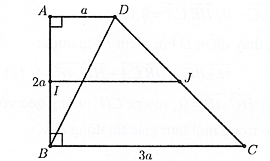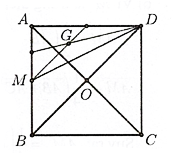Cho hình chữ nhật \(ABCD\). Kẻ \(BK \bot AC,K \in AC\). Gọi \(M,N\) lần lượt là trung điểm của \(AK\) và \(CD\). Tìm số đo góc \(\widehat {BMN}\).
Cho hình chữ nhật \(ABCD\). Kẻ \(BK \bot AC,K \in AC\). Gọi \(M,N\) lần lượt là trung điểm của \(AK\) và \(CD\). Tìm số đo góc \(\widehat {BMN}\).
Quảng cáo
Trả lời:

Đặt \(\overrightarrow {BA} = \vec a,\overrightarrow {BC} = \vec b,\overrightarrow {BK} = \vec c\) và \(BA = a,BC = b,BK = c\). Khi đó: \(\overrightarrow {BM} = \frac{1}{2}(\vec a + \vec c),\overrightarrow {MN} = \overrightarrow {MB} + \overrightarrow {BC} + \overrightarrow {CN} = - \frac{1}{2}(\vec a + \vec c) + \vec b + \frac{1}{2}\vec a = \vec b - \frac{1}{2}\vec c = \frac{1}{2}(2\vec b - \vec c)\).
Do đó: \(\overrightarrow {MN} \cdot \overrightarrow {BM} = \frac{1}{4}(2\vec b - \vec c)(\vec a + \vec c) = \frac{1}{4}\left( {2\vec a \cdot \vec b - \vec a \cdot \vec c + 2\vec b \cdot \vec c - {{\vec c}^2}} \right)\)
\( = \frac{1}{4}[2\vec a \cdot \vec b + (\vec b - \vec a)\vec c + (\vec b - \vec c)\vec c]{\rm{. }}\)
Ta thấy rằng: \(\vec a \cdot \vec b = 0\) do \(\vec a \bot \vec b;(\vec b - \vec a)\vec c = \overrightarrow {AC} \cdot \vec c = 0\)
Do \(AC \bot BK;(\vec b - \vec c)\vec c = \overrightarrow {KC} \cdot \vec c = 0\) do \(CK \bot BK\).
Vì vậy
Hot: 1000+ Đề thi cuối kì 1 file word cấu trúc mới 2025 Toán, Văn, Anh... lớp 1-12 (chỉ từ 60k). Tải ngay
- Trọng tâm Lí, Hóa, Sinh 10 cho cả 3 bộ KNTT, CTST và CD VietJack - Sách 2025 ( 40.000₫ )
- Sách - Sổ tay kiến thức trọng tâm Vật lí 10 VietJack - Sách 2025 theo chương trình mới cho 2k9 ( 31.000₫ )
- Sách lớp 10 - Combo Trọng tâm Toán, Văn, Anh và Lí, Hóa, Sinh cho cả 3 bộ KNTT, CD, CTST VietJack ( 75.000₫ )
- Sách lớp 11 - Trọng tâm Toán, Lý, Hóa, Sử, Địa lớp 11 3 bộ sách KNTT, CTST, CD VietJack ( 52.000₫ )
CÂU HỎI HOT CÙNG CHỦ ĐỀ
Lời giải
|
a) Đúng |
b) Sai |
c) Sai |
d) Đúng |

a) Tính \(\overrightarrow {AB} \cdot \overrightarrow {BD} \). Ta có: \(\overrightarrow {AB} \cdot \overrightarrow {BD} = \overrightarrow {AB} (\overrightarrow {BA} + \overrightarrow {AD} ) = \overrightarrow {AB} \cdot \overrightarrow {BA} + \underbrace {\overrightarrow {AB} \cdot \overrightarrow {AD} }_0\)
\( = \overrightarrow {AB} \cdot \overrightarrow {BA} = - {\overrightarrow {AB} ^2} = - A{B^2} = - 4{a^2}{\rm{. }}\)
b) Tính \(\overrightarrow {BC} \cdot \overrightarrow {BD} \). Ta có: \(\overrightarrow {BC} \cdot \overrightarrow {BD} = BC \cdot BD \cdot \cos (\overrightarrow {BC} ,\overrightarrow {BD} ) = BC \cdot BD \cdot \cos \widehat {DBC}\)
\( = BC \cdot BD \cdot \cos \widehat {BDA} = BC \cdot BD \cdot \frac{{AD}}{{BD}} = BC \cdot AD = 3{a^3}{\rm{. }}\)
(trong đó \(\widehat {DBC} = \widehat {BDA}\) vì là hai góc so le trong).
c) Tính \(\overrightarrow {AC} \cdot \overrightarrow {BD} \).
Ta có: \(\overrightarrow {AC} \cdot \overrightarrow {BD} = (\overrightarrow {AB} + \overrightarrow {BC} )(\overrightarrow {BA} + \overrightarrow {AD} ) = \overrightarrow {AB} \cdot \overrightarrow {BA} + \overrightarrow {AB} \cdot \overrightarrow {AD} + \overrightarrow {BC} \cdot \overrightarrow {BA} + \overrightarrow {BC} \cdot \overrightarrow {AD} \)
\( = - {\overrightarrow {AB} ^2} + 0 + 0 + BC \cdot AD \cdot \cos {0^0} = - A{B^2} + 3a \cdot a \cdot 1 = - {(2a)^2} + 3{a^2} = - {a^2}.\)
d) Tính \(\overrightarrow {AC} \cdot \overrightarrow {IJ} \). Ta có:
\(\overrightarrow {AC} \cdot \overrightarrow {IJ} = (\overrightarrow {AB} + \overrightarrow {BC} ) \cdot \overrightarrow {IJ} = \underbrace {\overrightarrow {AB} \cdot \overrightarrow {IJ} }_0 + \overrightarrow {BC} \cdot \overrightarrow {IJ} = BC \cdot IJ \cdot \cos {0^0} = 3a \cdot 2a \cdot 1 = 6{a^2}.\)
Lời giải
|
a) Sai |
b) Sai |
c) Đúng |
d) Đúng |

Độ dài đường chéo hình vuông \(ABCD\) cạnh \(a\) là \(AC = BD = \sqrt {{a^2} + {a^2}} = a\sqrt 2 \).
Ta có: \(\overrightarrow {AB} \cdot \overrightarrow {CA} = - \overrightarrow {AB} \cdot \overrightarrow {AC} = - |\overrightarrow {AB} | \cdot |\overrightarrow {AC} | \cdot \cos (\overrightarrow {AB} ,\overrightarrow {AC} )\)
Ta có: \(\overrightarrow {AD} \cdot \overrightarrow {BD} + \overrightarrow {OM} \cdot \overrightarrow {AC} = \overrightarrow {DA} \cdot \overrightarrow {DB} + \frac{1}{2}\overrightarrow {DA} \cdot \overrightarrow {AC} = |\overrightarrow {DA} | \cdot |\overrightarrow {DB} | \cdot \cos (\overrightarrow {DA} ,\overrightarrow {DB} ) - \frac{1}{2}\overrightarrow {AD} \cdot \overrightarrow {AC} \)
Ta có \(\overrightarrow {AB} + \overrightarrow {AD} = \overrightarrow {AC} \) (quy tắc hình bình hành).
Do đó: \((\overrightarrow {AB} + \overrightarrow {AD} )(\overrightarrow {BD} + \overrightarrow {BC} ) = \overrightarrow {AC} (\overrightarrow {BD} + \overrightarrow {BC} )\)
(trong đó \(\overrightarrow {AC} \cdot \overrightarrow {BD} = 0\) vì \(\overrightarrow {AC} \bot \overrightarrow {BD} \) ).
Lời giải
Bạn cần đăng ký gói VIP ( giá chỉ từ 199K ) để làm bài, xem đáp án và lời giải chi tiết không giới hạn.
Lời giải
Bạn cần đăng ký gói VIP ( giá chỉ từ 199K ) để làm bài, xem đáp án và lời giải chi tiết không giới hạn.
Lời giải
Bạn cần đăng ký gói VIP ( giá chỉ từ 199K ) để làm bài, xem đáp án và lời giải chi tiết không giới hạn.
Lời giải
Bạn cần đăng ký gói VIP ( giá chỉ từ 199K ) để làm bài, xem đáp án và lời giải chi tiết không giới hạn.